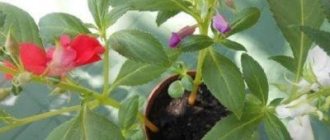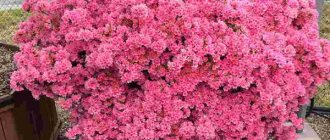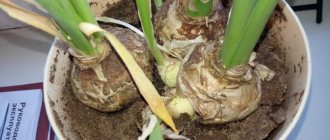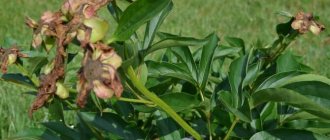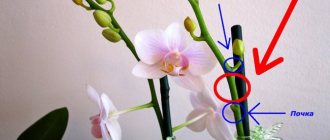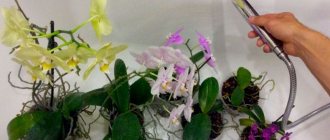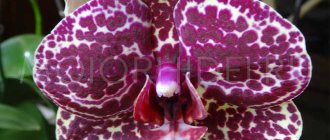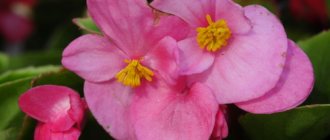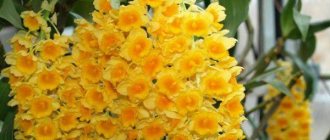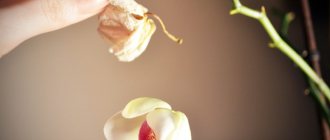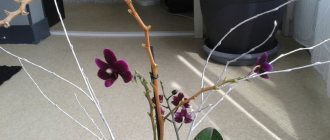Begonia Elatior or winter begonia is the most popular of the begonias today, because... It blooms almost all year round and has a huge variety of colors. Elatior begonia flowers can be of almost any color: red, pink, white, yellow, orange, salmon. After purchasing, the begonia must be transplanted into a container if it is a houseplant. When choosing a pot, pay attention to its size - it should not be too large. After the root system has grown, the plant should be transplanted into a larger pot or divided into several parts. Begonia Elatior loves good light, but it should be protected from direct sunlight. In our article we will talk about replanting Elatior begonia after purchase.
How to properly replant Elatior begonia after purchase
If you bought the plant already in bloom, then you must wait until this period passes, otherwise you may simply kill the flower. And after our beauty has bloomed, gained green mass, and the roots have begun to climb out both from above and from the drain holes, you can transfer it to a larger pot. The fact is that begonia is a very delicate plant. When replanting, you need to be careful with the roots, which, if you touch or damage them, can immediately “inflame” and begin to rot. Then you will have to use special care techniques, even spend money on drugs, biostimulants, and buy land and fertilizers again. As you understand, this is very difficult, and quite expensive, so you’d better worry about how to properly transplant begonia, which means waiting for it to bloom.
Latest articles about gardening
Other rules for replanting this beautiful flower also include: choosing a soil mixture suitable specifically for begonias, what method to transfer the begonia to a new pot, how to choose the pot itself, as well as how to care for it - water and feed the begonia after it has already been replanted after purchase . You can buy a soil mixture for begonias at any store that specializes in flowers, or even directly with the plant you are buying. We often advise our clients this way. You can prepare the soil mixture yourself, which should consist of leaf soil (about 1/2), and the remaining half of the volume of the pot should be filled with peat and humus - as you can see, the soil mixture is quite dense and nutritious, so you also need to put it on the bottom of our pot some sand. After the plant is planted, careful and high-quality care must be provided.
Cutting method
Most often, Elatior begonia is propagated by cuttings. The tops of shoots with two leaves or single young leaves on a long petiole are suitable for this. Rooting in water can lead to rotting of the stem, so it is better to use a sand-peat mixture for this purpose; perlite is also quite suitable.
The substrate is moistened and the cuttings are planted into it at a slight angle, deepening it by 1-1.5 cm. The leaf itself should not touch the surface of the substrate. After this, the cutting is covered with a glass jar and placed in a well-lit place where direct sunlight does not reach. The substrate is periodically moistened, and the jar is removed for a short time for ventilation. The ideal temperature would be 24-26°C. Rooting occurs in 1-1.5 months.
As new shoots grow, the cuttings are transplanted into larger pots, fertilized and provided with long daylight hours with the help of additional lighting. To set flower stalks, after a month the daylight hours are reduced to 8-9 hours, covering them with light-proof material. After 1-2 weeks, the previous growing conditions return. Flowers will appear on young begonias after 2-2.5 months.
Reproduction of begonia Elatior
It is carried out in several ways - cuttings, dividing the mother bush and seeds.
- It is best to root cuttings in soilless substrates, such as perlite or vermiculite. You can also root it in a glass of water, in which you should put an activated carbon tablet. The container with the leaves is placed in a dark place for two months, i.e. until they germinate and a young plant appears. The cutting must be at least five centimeters long.
- Propagation by stem cuttings follows the same principle. For cultivation, stems about seven centimeters long are taken. Planting of stems is carried out immediately after cutting them. Propagation by cuttings is carried out in early spring.
- Reproduction of Elatior begonia using seeds is a painstaking process. And only one variety can be grown in this way - F1 Charisma. All other varieties of this flower are hybrids, the seed material from which cannot be collected.
What to do next with wilted buds?
Even during the period of active flowering, all faded buds are removed. Some carefully cut, others twist. This way you will gradually remove the entire flowering part, and by the end of flowering the question will disappear by itself. Why do this? During flowering in this way, you save the plant's energy for more luxuriant flowering. At the end of this period, you also help the plant get rid of unnecessary things in order to prepare for dormancy. And in the end, wilted flowers are not aesthetically pleasing; they spoil the appearance of the begonia, making it sloppy and unkempt.
For this purpose, the largest and healthiest fruits are left, the rest are cut off. 20-25 days after flowering ends, the capsule ripens. It is opened and the seeds are taken away. From these seeds you can grow new young plants using seedlings.
Lighting for begonia Elatior
Articles for gardeners
For successful growth, it is necessary to provide good bright lighting, but not direct sun from morning until evening, which happens on south-facing windows. Ideally, of course, a certain amount of direct sunlight should fall on the begonia, because this makes the flowering more abundant and brighter, and the plant itself looks more interesting from this. In general, if you are guided by the cardinal directions, then place it on the windowsill of a north or east window. If you take into account the general illumination, then place it on the windowsill (this is a flowering plant!), where there is only a few hours of sunlight, in the morning or towards sunset.
Peculiarities
Begonia has flowers of different sexes: there are female flowers with pistils, and male flowers with stamens. How to tell them apart:
- On the back side of the flower, female flowers have a bulge - the future seed capsule; male flowers have nothing there.
- Double flowers in the corresponding species can only be male; female flowers cannot be double. But male flowers, at the same time, can be simple.
- If you understand what pistils and stamens look like, you can simply see them. By the way, some double male flowers may have no stamens at all. It is the modified stamens that make the flower double.
Interesting fact! Removing female flowers from their very formation can significantly increase the flowering period of begonias, as well as increase its intensity. But only if you don't want to get seeds.
Plant during flowering
From the moment it awakens, the plant begins to accumulate strength and nutrients for the upcoming flowering. Buds are laid and reproductive organs are formed.
When the begonia is ready to reproduce, first the male and then the female flowers bloom. If pollination occurs, which is done by hand, then the male flowers wither, and in the female flower a fruit-box with seeds begins to ripen. This is the time of the highest activity of the plant.
At this time, a huge amount of nutrients and microelements is consumed. An accelerated metabolism requires more water, sunlight and heat.
Heat Requirements for Begonia Elatior
Begonia Elatior is a heat-loving flower. At home, a temperature within 18-20 degrees is ideal for full growth and abundant flowering of this hybrid. At low temperatures, the plant stops its growth and sheds its foliage and flower buds. In addition, under such conditions, the flower begins to suffer from root or stem rot. Sudden temperature changes and drafts are contraindicated for him. When ventilating the room, the flower must be protected from cold air.
Description
Compact herbaceous plant, low, maximum 40 cm, perennial, often grown as an annual. It can be either a houseplant or an open ground plant. Shiny juicy foliage, fleshy stems, small flowers, 3-5 cm, can be either single or double. The most common forms are those with semi-double flowers. The colors are bright, neon, or two-tone. Range of shades: white, pink, yellow, orange and red. All hybrids are divided into three groups according to growth:
- Short.
- Medium height.
- Tall.
As a rule, Elatior begonia is grown for one season; by the next year the plant loses its decorative effect (grows). The plant can be found on sale very often, it is such a rewarding crop, adapted to indoor conditions, it is sold all year round. It is often confused with ever-flowering (ever-blooming) begonia, and even in stores you can find ever-blooming begonia Elatior for sale, but botanically these plants have different Latin names (ever-blooming begonia - Begonia Semperflorens).
Caring for Begonia Elatior
Windows on the west and east sides are best suited for growing it. The plant located on the southern windowsill will bloom profusely, but with small flowers. From excess sun, double varieties will reduce the number of petals and become pale. To keep the plant healthy and beautiful, the leaves are regularly wiped from dust, fallen and faded flowers are removed, and space is provided for growth. To form a lush bush, it is advisable to pinch the tips of the shoots two or three times.
Basic care for Elatior begonia at home includes systematic and proper watering. The plant should be watered moderately, so as to prevent the soil from becoming waterlogged. It is better to underwater this flower than to overwater it.
In this article we will talk about transplanting Elatior begonia and what to do with it after purchase.
How to properly replant Elatior begonia after purchase
If the plant was purchased in bloom, then you should wait for this process to complete, since replanting begonias after purchase during flowering is not recommended. If this condition is not met, the flower may die. It’s worth waiting until it gains green mass.
The plant must be transplanted urgently if:
- the root system has outgrown the container in which it is located, that is, the roots look out of the drainage holes;
- yellowness has appeared on the foliage or any other manifestations of a fungal disease;
- parasites were discovered that, as a rule, live and lay eggs in the soil;
- there are visible problems with the flowerpot.
When transplanting a seedling, follow the algorithm below:
- When replanting begonias at home, you need to decide on a pot: plastic or ceramic. If you choose plastic, then wash it thoroughly and soak it in water for a day. After this time, pour boiling water over the pot. If your choice fell on a ceramic flowerpot, then you have saved yourself 24 hours of waiting. Everything is quite simple with it: wash it and just scald it.
- Fill the bottom of the pot with a layer of expanded clay. If you want to protect the plant from root rot, then lay a thin layer of charcoal on top.
- Cover the drainage layer with 2 cm of soil.
- Water the begonia thoroughly and wait 50 - 70 minutes. After the expiration date, carefully remove it from the pot and shake off the old soil from the root system. It is better to rinse the rhizome in a non-concentrated solution of potassium permanganate.
- Trim off any rotted or damaged areas of roots.
- Place the plant in a new container and very carefully cover the roots with fresh soil.
- Check the position of the root collar; it should not be buried.
Further care of the plant
When you replant an indoor begonia, it is important to know how to care for it after the “relocation” procedure. Below are general guidelines to follow.
Temperature
The most comfortable range is considered to be from 18 to 20 degrees Celsius. However, to increase the duration of flowering, it can be lowered to 14-16 degrees Celsius.
What to do with the planting after flowering? It is often viewed as a short-lived floral arrangement and discarded early.
To prolong its existence:
- After flowering ends, keep the flower at 18 degrees Celsius. Don't overwater it; moderate watering is what you need.
- When winter is over, transplant the plant into fresh soil and trim it, leaving only three or four shoots.
- During active growth, regularly feed the flower and periodically pinch it, forming a compact bush.
- The plant will bloom again soon. But don't expect flowering until autumn.
Lighting
The ideal place to place the shrub is a window sill or a place in close proximity to a bright window. If the windows are south oriented, then in the summer, refract the sun's rays using some kind of shading.
In bright sun, the plant will bloom much more abundantly than in partial shade. But you should prepare in advance for the fact that the number of inflorescences will noticeably deplete, the flowers themselves will become significantly smaller, and their color will turn pale. And if your plant has densely double inflorescences, then the size of the petals, especially the inner ones, will noticeably decrease.
You need to carefully monitor the bush under such conditions, because the risk of burns increases significantly.
What you need to know before buying Elatior begonia
This variety of begonia was cultivated in London by Z. Veitch at the end of the 19th century. The scientist crossed the Socotrans and tuberous varieties and got an excellent result: an ornamental, long-flowering plant. Elatior begonia blooms from early autumn to late winter.
Begonia Elatior - Latin name Begonia Elatior (Begonia Reniformis, Begonia X Hiemalis, Begonia Rieger) is a perennial shrub. The height of the bush usually reaches 30-40 cm, the leaf is heart-shaped with jagged edges of a rich green color, the stems are fleshy. Flowers of different colors are collected in inflorescences and can reach 8 cm in diameter. This is an indoor flower native to tropical forests. This origin determines the minimum conditions important for good growth and flowering: warmth, abundant watering and rich soil.
Begonia Elatior has several varieties, the most common of which are:
- Borias (Borias) with soft pink flowers with a white border;
- Baladin (Baladin) with scarlet double flowers;
- Annabelle with yellow flowers. Most often used as a garden plant.
Important! Before purchasing a begonia from a flower shop, you need to carefully examine the plant. There should be no insects, cobwebs or stains on or under the leaves. They should be smooth and elastic.
Experts advise choosing plants with buds that are not fully open, since actively flowering begonia can drop its flowers if conditions change abruptly.
Varietal diversity
As you can see in the photo, begonia elatior (this flower requires special care) is a very beautiful and delicate plant. The capricious beauty requires careful treatment.
It does not tolerate significant disturbances of normal growing conditions. The varietal diversity amazes with the bright colors of the buds. There are low, medium and tall plants.
The Borias variety is very popular among gardeners. This hybrid has a compact shape. Flowers can be double or smooth. They are painted in two colors. Most often it is a light pink shade with a white edge. This plant is quite picky to care for.
Another popular variety is Baladin. The flowers are bright red, pink or white. Characterized by abundant flowering. It grows up to 30 cm in height. The flowers should not be touched with your hands. This causes them to develop unsightly brown spots. Other popular varieties include Annabelle, Azotus, Bellona, Kyoto, etc.
When to replant after purchase
Immediately after purchase, it is important to avoid mistakes that could even lead to the death of the plant. Begonia Elatior can be replanted after purchase only when it has completely bloomed. An emergency transplant is possible if the flower is flooded with water or the soil in the pot is of questionable quality.
In all other cases, you should think about replanting after flowering and new leaves grow. Signs of the need for replanting can also be considered roots that are cramped in the pot and begin to crawl out.
The new pot should not be much larger than the old one. It is best to buy a special soil mixture for replanting begonias in advance at a specialized store or prepare it at home. To do this, you need leaf soil (half the volume), peat and humus. You need to add a layer of sand to the bottom of the pot.
Important! If there is no special mixture for begonias, you can use soil for violets or any universal soil that contains peat.
Begonia Elatior is carefully transferred into a new pot along with a lump of earth. It is important not to damage the roots of the plant, otherwise they may begin to rot.
How to propagate Elatior begonia at home
Begonia Elatior can be propagated in four ways at home:
Propagation by tubers is a rather complicated process, and without experience, you can destroy the entire plant.
Growing from seeds is difficult, since Elatior begonia is a hybrid, and it is impossible to collect seed material from most varieties.
Seeds cannot be collected
To use a leaf for propagation, it must be cut off from the cutting and placed in a glass of water. As soon as the roots appear, the plant should be planted in the ground.
But the most popular method of breeding Elatior begonia is cuttings.
Reproduction of begonia Elatior by cuttings
This method is the most effective and gives quick results. For cuttings, it is better to choose a period of active growing season - spring or summer. There is an opinion that cuttings rooted in summer produce low-growing bushes that do not have time to grow before flowering begins.
Preparing the cuttings
Required tools and materials:
- disinfected knife or pruning shears;
- root formation stimulator or heteroauxin solution.
For rooting, choose apical cuttings with a pair of leaves and buds; the required length is about 8-10 cm. The cutting must be cut from the mother plant at an angle of 45°. After drying the cut a little in the air, you should dip the cutting in a root formation stimulator or leave it overnight in the prepared solution.
Diseases and pests
Maintenance errors, primarily stagnation or lack of moisture in the soil, weaken the plant and provoke powdery mildew. In this case, you need to optimize watering and treat the begonia with fungicides.
The combination of high humidity and low temperature leads to the development of root or leaf rot. If the process has just begun, you should urgently optimize the temperature and humidity conditions and remove damaged parts. In case of severe damage, you will have to root cuttings cut from healthy shoots and keep them in appropriate conditions, and get rid of the rest of the plant.
Begonia can be attacked by spider mites, aphids, scale insects, thrips and mealybugs. As a first measure, insects are removed using a cotton swab dipped in alcohol or treated with a soap solution. The most effective pest control is systemic insecticides.
Begonia elatior is a beautiful hybrid of two geographically distant “parents” - it is exclusively decorative during the period of abundant long flowering, which also extends into winter. At the end of this flower “fireworks”, having neither tuberous nor bulbous “reserve of strength”, the plant most often takes a long time to come to its senses.
However, when propagated from cuttings or seeds, Begonia elatior gives birth to young plants that are capable of repeating the same flowering feat.
How to care for begonia Elatior at home
Begonia Elatior is a very delicate plant, so it is worth providing all the necessary conditions and, if possible, not exposing the flower to stress.
Lighting
It is optimal to place Elatior begonia on windows facing east or west. This way the lighting will be sufficient, but without direct sunlight. If placement is possible only on southern windows, the plant should be covered and created partial shade. Excess sun causes flowers to become small and pale, and in double varieties the number of petals decreases. In winter, additional lighting is not needed.
Important! Begonia Elatior should not be disturbed or turned towards the light. This can cause the buds and leaves to drop.
Temperature and humidity
The suitable temperature for keeping Elatior begonia is 18-20°C. At lower temperatures, the flower stops growing and may shed its buds. If low temperatures are maintained for a long time, the plant may develop root rot. Begonia must be protected from drafts and sudden changes in conditions.
It is not recommended to spray begonia. To maintain the required humidity, it is better to place the pot on a tray filled with wet expanded clay. Leaves can be wiped from dust with a damp cloth or brush.
Watering
The main rule is that it is better to underfill than to overfill. It is recommended to wait until the earthen ball is half dry before watering the plant. If the water stagnates, the stems or roots may rot.
Top dressing
For feeding, complex fertilizers based on minerals are used, which are applied in half the amount specified in the instructions. During the period of active growth and flowering, fertilizers are applied regularly, every 10 days. If the plant is transplanted into new soil, fertilizing should be postponed for at least 2 months.
Organic fertilizers should not be used, as the nitrogen they contain makes the plant stems brittle and transparent, and the flowers less spectacular.
Note! To stimulate lush flowering, you can use fertilizers containing a lot of phosphorus and potassium.
The soil
Begonia Elatior, like all representatives of begoniaceae, is picky about the composition of the soil, so it is advisable to use only special soil mixtures. The substrate should be nutritious and coarse; deciduous soil with peat, humus and sand is best suited.
Transfer
Caring for Elatior begonia at home necessarily includes replanting. Every spring you need to replant the plant in fresh soil. It is worth making sure that the root collar is always above the surface, otherwise the flower may begin to rot.
When to prune Elatior begonia
Pruning is necessary to maintain health and form a beautiful crown of the plant. For the first time, a young plant is pruned when it reaches a length of 7 cm, thereby stimulating the growth of side shoots. It is recommended to reduce watering until fresh leaves appear.
When the side shoots reach 10 cm, they are cut off again. The cut location should be above the bud on the outside of the stem. Further pruning is done as necessary.
Diseases and pests
Of all the diseases, begonia is most susceptible to all kinds of rot and powdery mildew. Why is this happening? Diseases are most often caused by care errors associated with excessive watering and too low a temperature. Dark, softened areas appear on the stem and leaves. If the roots are affected, brown spots will appear on the leaf blades. With powdery mildew, the stem and leaves become covered with characteristic white spots.
If the root system is affected, alas, the begonia will definitely die. When diseases of the aerial part begin, the affected areas are removed, and the plant is treated with Bordeaux mixture, fungicide or phytosporin, using them in accordance with the instructions on the package.
Since the top of begonia leaves is dense and glossy, pests settle on their underside. The movements of aphids can be seen with the naked eye. The spider mite is invisible, but it can be recognized by the appearance of cobwebs on the begonia and traces of vital activity in the form of small yellowish drops on the leaves. The mealybug is a very small white insect. Modern insecticides successfully combat all these pests. A double treatment is enough to get rid of them for a long time.
Begonia flower
What to do after Elatior begonia blooms
No special measures are required after the end of the flowering period; it is enough to remove the empty flower stalks. If the plant has grown greatly, you can prune and root the cut shoots. What to do next with the cutting is described above.
From the article it is clear that Elatior begonia is a wonderful flower for decorating home windowsills. However, it requires some kind of care, which consists of selecting a suitable place, timely watering and fertilizing. If you follow the rules above, the begonia will bloom for a long time, pleasing the eye of the gardener.
